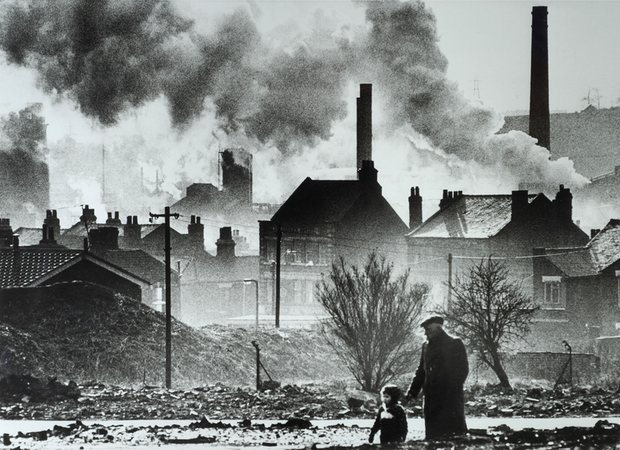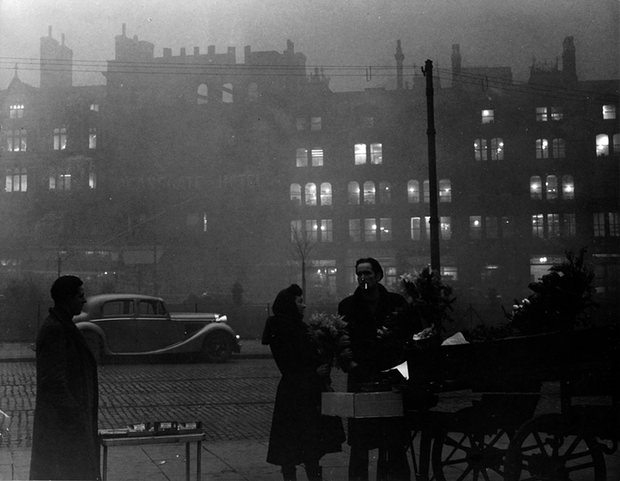|
Pollution
Life before the Clean Air Act - your memories and pictures
To mark the 60th anniversary of the Clean Air Act, we’ve been asking Guardian readers to share their memories and stories of what the UK was like before the act came into force.

The brilliantly lighted Underground sign serves as a fog beacon for Londoners. Photograph: Alamy
The great smog of 1952 swathed London in a toxic smog of pollution, resulting in thousands of deaths over a four-day period. The Clean Air Act was a groundbreaking piece of legislation that led to the phase-out of coal in Britain’s towns and cities.
Sheila Romain, 88, West Sussex
“Coming home from school one day I caught the bus from Crystal Palace to Dulwich. When we got to Gypsy Hill the bus driver said he couldn’t see well enough to go on. I got off knowing I could walk home. When the driver saw in which direction I was going he asked if he could follow me. So, for the next mile and a half, the bus followed me. This must have been the winter 1946-47.”
Philip Lord, 70, Dollar, Scotland
“I was born in London (and went to school there) and remember the smogs well. As a kid we used to welcome them since we were let off school when they occurred. People nowadays do not understand how thick the smog could be - it was difficult to see your hands at arm’s length in the worst smogs, and world became ghostly, quiet and eerie. They had a particular smell of coal smoke and sulphur; recalling the smell takes me right back to that time. As a child there was something enclosing and cosy about the smogs - I think it was because you stayed indoors, felt safe and warm in front of the fire - the very fire that was contributing to the fog itself. The outside world became fuzzy - the street lights became yellow pools, edges disappeared. I was fit and healthy and the fog did not affect me as far as I was aware; for the sick and particularly those with respiratory diseases they must have been awful.”

An elderly man and child walk across some wasteland. Smoke and pollution from the local factories can be seen in the background. Photograph: Getty Images
Anonymous, 80, Wigan
“I was a trainee student nurse and just one incident sticks in my mind. I was allocated to work at an out-of-town fever hospital to cover for nurses in sick bay suffering from Asian flu. At 8.30pm I was standing at a bus stop, I couldn’t see anything having left the hospital feeling for the wall to reach the bus stop. No lights were visible, not from the hospital, nearby houses or streetlights the smog was so dense. I hadn’t felt well all day and was coughing. After about an hour, no bus hadn’t arrived of I hadn’t seen it. Apparently I collapsed and a person found me slumped to the floor. He had a torch and recognised my uniform and made his way to the hospital for help. I too woke up in the sick bay. Eventually a police officer made it to my home to tell my parents. It wasn’t a one-off in winter, it hardly seemed to fade. Transport would often be cancelled. The Clean Air Act was a blessing for everyone especially for the elderly and young children and people with asthma. A new clean air act is vital - it is criminal not to.”
Stella Enright, 66, Cornwall but grew up in London
“I grew up in Walthamstow, east London. The smogs were horrific, we had to wear our scarves over our mouths to go outside and the outside of them became coated in a thick, brown and sticky substance. I 1953 I remember my mother guiding my dad with a torch as he drove my aunt to the maternity hospital for the birth of my cousin; my mother was walking in front of him with her scarf firmly over her mouth. I remember that, in the winter, clean washing hung outside would become covered in black specks of soot because of coal fires. Lots of people had bad chests all winter, myself and my sister included.”
Robert Taylor, 76, Oldham, Lancashire
“We had smogs as bad as the London ones. From time to time my father would have to walk home the six miles from Manchester when the buses were off. I remember a Christmas post round when the uphill half of my walk was in sunshine, and the rest in smog leaving not six feet of vision. We only saw the moors of Lancashire and Cheshire during Wakes week [a religious holiday in cotton mill towns of the north-west]. I once counted 64 mill chimneys from my bedroom window.”
Una Allcock, 70, Dorset
“I was born in a four-roomed slum of a house in Deptford, London. One small open fire provided our only source of heat. The coal we burned was filthy stuff and I can remember the thick yellow smoke billowing up the chimney - just like every other house in my part of London ...
“I remember one afternoon when although there was no smog at street level the sky darkened and my mother at first thought a storm was brewing. I know now that this was a cloud of smog that sat in the atmosphere. Neighbours ran into the street most thought that we were under attack, most adults then still remembered the war. It was early afternoon but it seemed like night time.
“We never complained about it, just endured it hoping it would clear up quickly. Thank goodness the days of coal fires banked up with potato peelings and coal dust are over for it is the greatest joy to me not to have to huddle round smoke to keep warm.”

Fog in Victoria Street, Manchester.
Fog in Victoria Street, Manchester. Photograph: Tom Studdart for the Guardian
Anonymous, 70, south of England
“The fogs went on long after the Clean Air Act, however. Think of the Lewisham train crash in 1957 - of which I have vivid memories, as my father would normally have been on that train. Rumours of the crash spread quickly among our neighbours. We sat at home for hour after hour waiting to hear the worst. The relief when he finally turned up, grey and drained, at about 11 pm, having had to take an epic series of buses to get home, is something I’ll never forget. We were lucky. Many other families weren’t.”
Mike Valpy, 66, West Sussex
“I must have been about three or four years old, which would have made it 1952 or 53, when we were on our way to my grandmother’s in Ruislip for Christmas. I remember sitting in the back of our family car, with my older sister beside me, and my father saying he couldn’t see where he was going and driving very, very slowly indeed - walking pace, no more. My mother, in the front passenger seat, was leaning out of the open front passenger door, looking down at the kerb and guiding my father by saying, ‘left a bit dear’, ‘right a bit dear’, ‘yes, that’s fine, keep going dear’.
“As it was freezing cold in the car, we were wrapped up in blankets on the rear seat for the duration of the journey, which seemed to take forever. We reached my grandmother’s safely, but obviously very much later than expected.”
|



